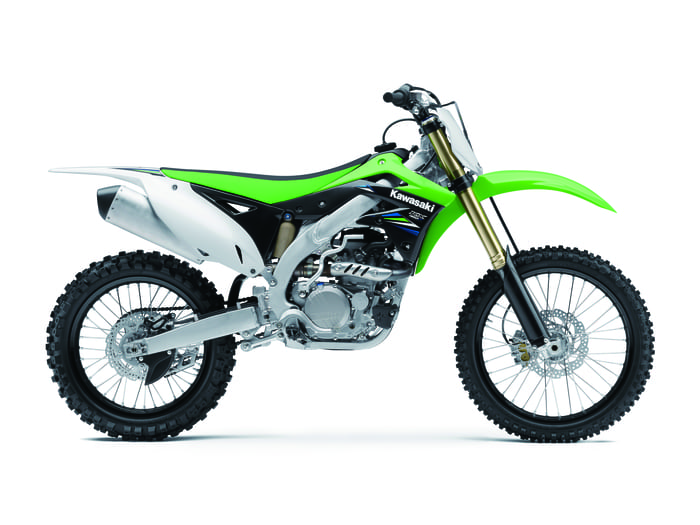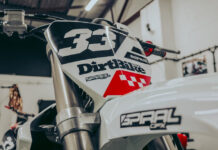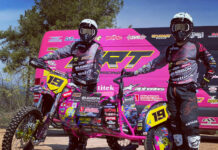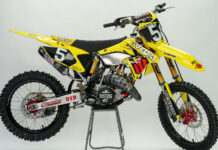With two 2014 KX-Fs to test and a mini two-stroke ripper to check out n’all DBR MX tester guru Ed Bradley has a much better – and safer – time at this year’s Kawasaki model launch…
I had been told that there was a surprise waiting for me in Germany when I went to test the latest offering of Kawasaki’s mean n’ green machines. However, I didn’t expect it to be me who was getting all the attention as the guy who stacked it on the first lap of last year’s test and needed the air ambulance to be taken away. Fortunately the bulk of the attention soon turned to Kawasaki’s new KX85. It’s been over 12 years since the 85 has had a sniff of an update and as they currently own a very small portion of the stagnant youth market – a revamp was well overdue.
For the sceptical, at a glance, there is nothing more than a plastics update which on its own merit makes a great contribution and enough to whet any young lad’s appetite. Now if you want to get sceptical you could look at the KX450F and say they’ve done jack with that too but you’d be wrong because the R&D guys have lengthened the left hand handlebar grip so that it doesn’t get in the way of the clutch lever!
Now that is confidence for you isn’t it? Sending out the same bike for the second year running, I mean. What has it achieved in the last 12 months anyway? Well, Kawasaki does have the fastest rider in the world right now and RV has absolutely dominated the SX series in America and is also smoking everyone outdoors too. On top of that Gautier Paulin is flamboyantly riding his machine to victories on our side of the pond and has looked like the only rider that could rattle Cairoli – even if it is for a short time.
Someone slipped up at Kawasaki last year because this year the presentation marked their 40thyear of producing motocross machinery during the 2014 range launch. Not that it matters, 40 years is a long time, in which, 31 AMA supercross titles have been won by the green meanies. A record for the manufacturer with the most held titles… every day is a school day when you are testing motocross bikes!
So what is it about the big boy that makes it such a strong bike? You’ve still got the launch control that makes jumping out of the gate bearable. It takes a strong man to hold this animal down so unless you’re the size of Geoff Capes you’ll continue to use this – and your holeshot device!
The EFI calibration kit has the weaker and stronger power plugs to compliment the standard setting which has been a great success for setting up your engine’s performance for on the day track conditions. Along with other adjustments, you can still change your footpeg height – a great idea as the four-fiddy does feel quite tall and if you are a little guy having this option is pretty cool.
Suspension wise Kawasaki is sticking with the new air fork. I love these forks, so plush with no stiction and no bottoming either. Yes, you have to continually check the pressure but once you’ve found what you are happy with, you are good to go and there is no messing around with fork springs to get the rates right or guessing what preload works best for you too.
Out on the track the Kawasaki is a favourite because of how well it performs in all areas. It’s a great all-rounder. It’s super stable and behaves like a teacher’s pet sat at the front of the class – it does exactly what you want it to and is very clever.
Although not so nibble on the tight turns – and the track we rode had plenty of incredibly tight turns – with a little effort you could persuade it around and it continues to behave and feel really safe. On the intermediate and more open turns the bike just gives you the feeling that it is as steady as a rock and you can hammer your way around with your right wrist to the stop.
And when your wrist is to the stop you better hang on because the power is awesome. Strong and torque with plenty of over-rev that matches the gearing really well. The gap between shifting up and leaving the end of the mid-range is just enough time to hit the next shift.
The brakes are pretty standard and work just as you would expect them too. In the air this bike also feels really stable, predictable and safe. Overall the KXF450F is a bike that doesn’t put a foot wrong. The whole unit works great and is well rounded off.
The KX250F has had its fair share of updates this year that go beyond just the wider clutch grip! The big news is that little brother now has launch control too which took me by surprise because after wrestling the 450 out of the gate in a Geoff Capes stylee, ripping off on a 250F is nothing short of a piece of p*ss! I’ll let you know how my starts went later…
The engine continues to use the very successful dual-stage injectors that were introduced a couple of years ago, giving the motor that extra life at the top-end. Lower down in the engine cases there have been some changes to the gearbox. The 2013 model gears used three dogs that meshed into each other. Now, the chunky metal cogs have four dogs that add strength to the gears and make a more positive feel when shifting. To complement the strong, positive shifting, the selector drum has been modified too to give a more precise and definite feel.
Outside the motor the engine has sturdier mounts so that there is a more rigid and direct feel. This is achieved by reducing flex at the front end. Along with creating a better feel the new little ripper is fitted with second generation Single Function Forks. They have received refinements and a firmer internal setting which creates a more positive feel with the track surface. Likewise, although the rear shock is still the same unit, the internal settings have been stiffened up to match the front and balance the bike.
Now bearing in mind that I had just got off the mighty machine that is the 450, just sitting on the 250F felt like getting on an 85! The seat height on the 250F is actually one centimetre lower than the big bore machine and it is quite amazing that it’s noticeable.
Also the clutch lever feels closer to the handlebar… great if you’ve got small hands but with buckets like mine it feels a bit too close. You can easily move the launch control button to the inside of the clutch perch and the bracket further to the inside of the handlebar so that the lever is further away. For the test though we left it there and I made sure there was only a little bit of play in the cable.
My first reaction to the power was that it was a little underpowered. However, I was comparing it to the 450! The more I rode it and the more body language I used the more impressive the bike’s power became. I love how this bike revs out. There is a smooth transition between the mid-range and top-end power and there is plenty of easy-to-use top-end. Not the sort that will have you spinning out everywhere – just smooth strong power.
I tested both EFI plugs against the standard setting and there was a considerable difference for the track we were riding. Along with the super tight turns there where a few long straights to rattle the engines cage. The white plug revved to the moon and was mega for the long, wide-open parts but lacked the edge exiting the slow corners. The black was just the opposite – awesome low-end power although the rev limiter was working over time on the longer, wide open stuff. The standard plug was brilliant for this track and I am sure that the other plugs will have their favourite going too.
The chassis and suspension work great together as the bike is easy to turn and picks up good traction out of the turns both in the mud and on the rock hard parts of the track.
Testing the launch control was interesting. The ground was dry and loose with tyres cutting into the ground by about 75mm so it was quite wishy-washy and easy for the rear wheel to spin. The first start I did without the launch control on saw me set off like a sidewinder snake on amphetamines! The back end was all over the place. With the setting on, there was a lot more traction and forward movement – it compliments the bike well and will be used often.
The piece de resistance of the new KX range is the 85 though and Kawasaki have now realized that they have been neglecting the youth movement that made them so dominant back in the day with their Team Green efforts. The focus is now back on the kids which makes it an exciting time for both youth riders and their parents as the Kwak bosses start to ‘Build Future Champions’ using this phrase as their tagline. Hopefully they’ll start winning some domestic championships again.
Obviously, the diddy two-strokes have had an external makeover and this gives the bike a look that’s similar to its bigger siblings but more importantly it has changed the ergonomics of the bike. There is now a slimmer seat that moves away from its old 1980 Maico-sized predecessor and the fuel tank is slimmer and flatter around the cap. Both these changes mean that the rider can now move around on the bike in way that allows them to use the techniques that kids are currently using instead of those from over 12 years ago! To make things even better for rider feel, the handlebar clamps are adjustable – just like on the big bikes. This is great news for the taller kid who has to wait before moving up class.
In the suspension department the forks now have 20 clickers on the compression adjustment and the shock has received internal revisions to get a better handling bike that suits the new ergonomics.
So far so good – now for the engine modifications. This motor is knocking out 20 per cent more power over the complete range and this is how they’ve done it. They’ve fitted a low friction piston that only has one ring for a freer revving stroke up and down the new Nikasil-lined cylinder and the top of the piston now explodes away from the head which has a new squish pattern for better combustion. All this improves the top end power.
For the bottom end, the crank has been packed with nylon blocks that not only add weight creating better inertia but also increasing the crank pressure for better performance too.
These are significant changes to the motor, however, the most significant change is to the power KIPS power valve system which is now a two-part valve rather than the single old longer one. The advantage being that there is a better seal and again boosts the motor’s performance.
The only question left is ‘have Kawasaki built a bike that can build champions as their tagline suggests?’. Our guy banging around the track was Dylan Woodcock who was riding with other Kawasaki representatives from France, Italy and Sweden. Watching Dylan was great. He looked loose and moved around on the bike really well. The motor sounded strong with a deeper note compared to the previous model which sounds zingy by comparison.
The feedback we got from Dylan was that it is better than his current race bike that has had plenty of attention and setting up. Other feedback I got was that the bike is so much easier to move around on because of the new layout and it felt very Kawasaki like – in that it was really stable in turns and on the straights. As a test rider I was just glad the young whippersnappers were on the track at a separate time to us!
Specification:
KX450F
KX250F
KX85-I (KX85-II)









